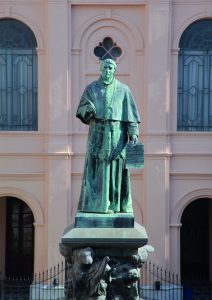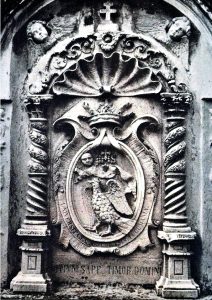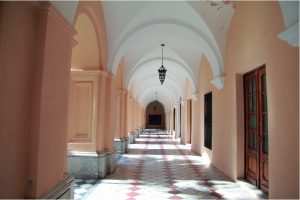[Audioguide]
This is the main court of the University’s first building. Over four centuries the building housed different functions, therefore some areas were remodelled and others disappeared in order to enlarge the building.
At present, the building houses the University’s Historical Museum, opened in the year 2000 as part of the inscription of the site “Jesuit Block and Estancias of Córdoba” in the World Heritage List by UNESCO. It also houses other sections of the university like Biblioteca Mayor (Central Library), the General and Historical Archive and departments of the School of Law. There is an internal passage to the West connected to the buildings of the School of Exact, Physical and Natural Sciences and the National Academy of Sciences.
With this tour we will visit the Ground Floor halls
1. a. Statue of Bishop Trejo y Sanabria

[Audioguide]
A majestic statue dedicated to Bishop Trejo y Sanabria stands at the centre of the court. It was designed by sculptor Victor de Pol and placed in 1903.
In 1613, Jesuits were struggling to support the Collegium Maximum in Córdoba city. This institution was in charge of the formation of the members of the Order and it was located here in Córdoba, head of the Jesuit administrative division called “Province of Paraguay”.
Trejo became aware of this situation and he promised to grant an annual rent towards the continuity of the Collegium in Córdoba. He also required that studies in the institution were to be open to other members of Córdoba’s community who were interested in studying Latin, Arts and Theology.
Trejo included this promise in his will, signed the 19th of June in 1613, and we consider that date as the foundation of the University. For that reason, sculptor Víctor de Pol decided to represent the Bishop in the manner of signing his will.
1. b. Coat of arms carved in stone

[Audioguide]
The University’s coat of arms is located over the arch, entering the Graduation Hall from the court. It is the earliest known example of the coat of arms and it dates from the Jesuit period (1613-1767). It is carved in soapstone, a type of metamorphic rock found in the Córdoba Mountains.
Despite the passing of time and the many transformations the University went through, its coat of arms suffered very few modifications.
1. c. Cross vaults

[Audioguide]
In the early 1700, when the University and the Collegium Maximum were already established, the building remained unfinished. Carlos Gervasoni, a jesuit, wrote in 1729:
“Our College is beautiful, however a part of it remains in the same conditions, and it is still inhabited; a part of it is built on bricks, but due to the lack of a vault, it rains everywhere”.
For this reason, another member of the Order, Brother Giovanni Andrea Bianchi was commissioned to build the vault we observe in the cloisters. They are known as “cross vaults” because they are formed by the perpendicular intersection of two barrel vaults.
By 1742 the finished vaults meant the completion of the Ground Floor, at least during the Jesuit period (1613-1767). It would take almost 150 years for the upper floors to be built.
